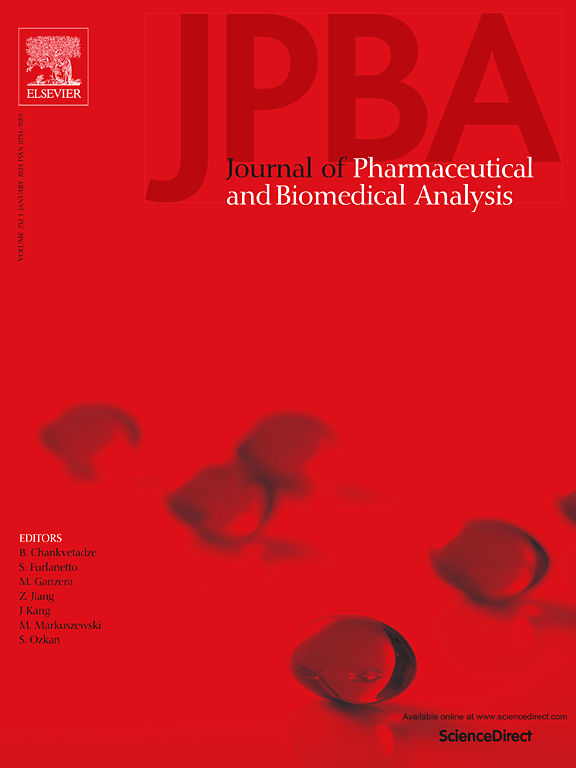Evaluation of Jacalin lectin sorbents for the extraction of the human chorionic gonadotropin glycoforms prior to analysis by nano liquid chromatography-high resolution mass spectrometry
IF 3.1
3区 医学
Q2 CHEMISTRY, ANALYTICAL
Journal of pharmaceutical and biomedical analysis
Pub Date : 2024-10-15
DOI:10.1016/j.jpba.2024.116525
引用次数: 0
Abstract
Human chorionic gonadotropin (hCG) is a dimeric, highly glycosylated hormone with a total of 4 N- and 4 O-glycosylation sites in its two subunits, hCGα and hCGβ. Recently, we developed a novel nano liquid chromatography coupled to high resolution mass spectrometry (nanoLC-HRMS) method for the analysis and thus the detection of the intact glycoforms of hCG. Here, a sorbent functionalized with the Jacalin lectin was evaluated in solid-phase extraction (SPE) for its potential to fractionate the hCG glycoforms prior to their nanoLC-HRMS analysis at the intact level, which may facilitate the detection of low-abundance glycoforms and may lead to a more detailed characterization of the hormone glycosylation. A commercial sorbent based on Jacalin immobilized on Sepharose and having a lectin density of 4.5 mg per ml of gel was selected to carry out SPE and its capacity was estimated to be of some tens of μg of hCG per ml of lectin sorbent. Next, the SPE protocol was modified to improve the extraction recoveries. Especially, it was noticed that an extensive pre-conditioning procedure prior to the first use of a cartridge was necessary to remove the residual non-grafted lectins. Indeed, if non-grafted lectins are not eliminated, they may bind a part of hCG glycoforms preventing their retention by the sorbent, leading to low extraction recoveries (around 10 %). With the extensive pre-conditioning procedure, the average extraction recoveries for both hCGα and hCGβ glycoforms were about 50 %, with either recombinant or urinary hCG. Qualitatively, the fractionation of hCG glycoforms between the washing and elution fractions was achieved with the urinary hCG sample by determining the number of glycoforms detected in each fraction. It appears that 12 hCGα glycoforms have a low affinity (detected only in the washing fraction), 1 a low-medium affinity (detected in washing and elution 1 fractions), 16 a medium affinity (detected in washing, elution 1 and 2 fractions), and 12 a high affinity (detected only in elution 1 and 2 fractions). For the hCGβ glycoforms, similarly, 3 have a low affinity and 12 a low-medium affinity. Additionally, the 3 hCGβ glycoforms were detected better. A different behavior was observed with the recombinant hCG sample, which indicates glycosylation differences between the two hCG samples. This shows the potential of lectin-based affinity fractionation before nanoLC-HRMS analysis to better characterize the glycosylation state of hCG at the intact level.
在采用纳米液相色谱-高分辨质谱法进行分析之前,对用于提取人绒毛膜促性腺激素糖形的贾卡林凝集素吸附剂进行评估。
人绒毛膜促性腺激素(hCG)是一种高度糖基化的二聚体激素,其两个亚基(hCGα和hCGβ)共有4个N-和4个O-糖基化位点。最近,我们开发了一种新型纳米液相色谱-高分辨质谱(nanoLC-HRMS)方法,用于分析和检测 hCG 的完整糖基形式。在此,研究人员在固相萃取(SPE)中评估了一种与Jacalin凝集素功能化的吸附剂的潜力,该吸附剂可在纳米液相色谱-高分辨质谱(nanoLC-HRMS)分析完整水平的hCG糖型之前对其进行分馏,这可能有助于检测低丰度的糖型,并可能导致更详细的激素糖基化特征描述。我们选择了一种固定在 Sepharose 上、凝胶凝集素密度为每毫升 4.5 毫克的商品化吸附剂来进行 SPE,估计每毫升凝胶凝集素吸附剂可吸附数十微克的 hCG。接下来,对 SPE 方案进行了修改,以提高提取回收率。特别是,我们注意到,在首次使用滤芯之前,有必要进行大量的预处理,以去除残留的非接枝凝集素。事实上,如果不去除非接枝凝集素,它们可能会与部分 hCG 糖形结合,从而阻碍吸附剂对其的保留,导致提取回收率较低(约 10%)。在广泛的预处理过程中,重组或尿液中 hCG 的 hCGα 和 hCGβ 糖型的平均提取回收率约为 50%。通过测定尿液中 hCG 样品在每个馏分中检测到的糖形数量,可以定性地在洗涤馏分和洗脱馏分之间对 hCG 糖形进行分馏。结果显示,12 个 hCGα 糖形具有低亲和力(仅在洗涤馏分中检测到),1 个具有中低亲和力(在洗涤和洗脱 1 馏分中检测到),16 个具有中亲和力(在洗涤、洗脱 1 和洗脱 2 馏分中检测到),12 个具有高亲和力(仅在洗脱 1 和洗脱 2 馏分中检测到)。同样,3 种 hCGβ 糖形具有低亲和力,12 种具有中低亲和力。此外,3 种 hCGβ 糖型的检测效果更好。在重组 hCG 样品中观察到了不同的行为,这表明两种 hCG 样品之间存在糖基化差异。这表明,在进行 nanoLC-HRMS 分析之前,基于凝集素的亲和分馏法有可能更好地表征 hCG 在完整水平上的糖基化状态。
本文章由计算机程序翻译,如有差异,请以英文原文为准。
求助全文
约1分钟内获得全文
求助全文
来源期刊
CiteScore
6.70
自引率
5.90%
发文量
588
审稿时长
37 days
期刊介绍:
This journal is an international medium directed towards the needs of academic, clinical, government and industrial analysis by publishing original research reports and critical reviews on pharmaceutical and biomedical analysis. It covers the interdisciplinary aspects of analysis in the pharmaceutical, biomedical and clinical sciences, including developments in analytical methodology, instrumentation, computation and interpretation. Submissions on novel applications focusing on drug purity and stability studies, pharmacokinetics, therapeutic monitoring, metabolic profiling; drug-related aspects of analytical biochemistry and forensic toxicology; quality assurance in the pharmaceutical industry are also welcome.
Studies from areas of well established and poorly selective methods, such as UV-VIS spectrophotometry (including derivative and multi-wavelength measurements), basic electroanalytical (potentiometric, polarographic and voltammetric) methods, fluorimetry, flow-injection analysis, etc. are accepted for publication in exceptional cases only, if a unique and substantial advantage over presently known systems is demonstrated. The same applies to the assay of simple drug formulations by any kind of methods and the determination of drugs in biological samples based merely on spiked samples. Drug purity/stability studies should contain information on the structure elucidation of the impurities/degradants.

 求助内容:
求助内容: 应助结果提醒方式:
应助结果提醒方式:


